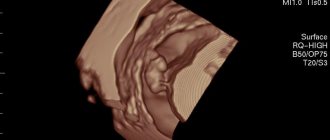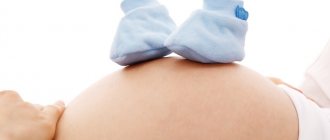The approaching birth can not only be a source of joyful anticipation of meeting your baby soon, but also cause a certain amount of anxiety. This is especially true for the first pregnancy. While waiting for the baby to appear, the expectant mother increasingly wonders how to understand that contractions have begun. It also happens that at the first urge, a woman rushes to pack her things for the maternity hospital, but then the discomfort disappears and causes bewilderment.
Let's talk about how to distinguish real contractions, whether you should be afraid of them, and when you really need to rush to the hospital.
Contractions: how to understand that they have begun
When contractions begin, a woman may feel them in different ways.
Sensations can be of three main types, which are often described by women in labor:
- Pain in the lumbar region.
- Pain as during menstruation.
- Cramping pain that spreads throughout the abdomen.
It is impossible to predict how much a woman will be bothered by contractions.
Much depends on the physiology and position of the child in the womb. But, despite the different nature of the sensations, every woman goes through three natural phases of the process: 1. Initial. The pain is mild. The contractions are short, and there are quite long breaks between them. This condition can last up to 8 hours. At this time, the expectant mother can take a warm shower or begin to gradually get ready for the maternity hospital. It is advisable to start marking the time intervals of contractions so as not to miss their transition to the next phase.
2. Active. The duration of contractions increases, the breaks become shorter. A woman may feel discomfort for up to 1 minute, after which a new contraction begins after a short period. The condition lasts from 3 hours. By the time only 5 minutes pass between contractions, it is highly advisable for a woman to already be under the supervision of a doctor.
3. Transitional. This phase is easy to skip on your own - it takes from half an hour to 2 hours and helps the cervix open to a state of full readiness (7-19 cm). At the same time, the woman notices the release of the mucus plug, which at other times “closes” the cervix. The time for the baby's birth is approaching2.
Center
When should we expect it?
In modern obstetrics, pregnancy is considered full-term at 38 weeks. Carrying a child for more than 41.5 weeks is considered post-term. Thus, urgent, that is, births that occurred on time, fall within the interval from 270 to 290 days. However, there are women who give birth to completely normal, healthy and full-term babies at 36 or 42 weeks. Moreover, these weeks can be counted in different ways, from the immediate date of conception or from the first day of the last menstruation. Taking into account the individual characteristics of each woman, it would be fairer to talk not about the actual date of birth, but about the most likely interval when they can occur. This interval usually varies from 2 to 5 weeks, i.e. in periods from 38 to 42 weeks.
As soon as the first day of the expected period arrives, the woman, in excitement, begins to monitor her condition very carefully and can interpret any ailment as a sign of the onset of labor. Going to the maternity hospital with unsettled labor, a woman in labor risks being “stuck” for several days in the pathology department or being subjected to immediate stimulation, or even surgical delivery (caesarean section). Therefore, it is necessary to go to the maternity hospital with labor already established. And to find out about your condition, it is not always necessary to call a specialist. For example, there are a number of phenomena that accompany the last weeks of pregnancy, which are called harbingers of labor. The presence of one or more precursors indicates that childbirth is coming soon, and for example, you shouldn’t go on a visit out of town, but it’s too early to go to the maternity hospital
dress rehearsal
Pain in the lower abdomen and lower back
In the last 3-4 weeks before childbirth, periodic nagging pain in the lower abdomen and lower back may appear. They may be spastic in nature. The appearance of such pain is a consequence of increased excitability of the nervous system, as well as displacement of the vertebrae in the sacrum, which can lead to pinched nerves. Sometimes, as a result of such infringement, in the last weeks of pregnancy the leg may be periodically amputated and immobilized. This phenomenon has a physiological basis and disappears without a trace after childbirth.
In addition, there may be a feeling of fullness, tingling and pain in the pubic area, which is associated with increased pressure from the adjacent part of the fetus on the symphysis (pubic bone). Wearing a bandage, as well as frequent rest in a lying position, helps to alleviate this condition. This phenomenon also goes away after childbirth.
Descent of the abdomen
2-4 weeks before giving birth, the pregnant woman’s stomach drops (“slides”). As the belly lowers, the woman notes that it has clearly changed its shape and seems to have become smaller. At the same time, it becomes noticeably easier to breathe and eat. This occurs as a result of the lowering of the presenting part of the fetus, thereby freeing the diaphragm, stomach and lungs.
Excitability of the uterus
Due to the increased excitability of the uterus, it begins to react more and more strongly to any irritants. Very often, 5-6 weeks before birth, tonic tension of the uterus occurs. First 1-2, then 3-4 times a week, and closer to childbirth and 1-2 times a day, the uterus can become very tense. At the same time, it becomes hard and this tension is present for quite a long time.
False contractions
In addition to tonic tension of the uterus, 3-4 weeks before birth, periodic contractions may occur, which are called harbingers of labor or false contractions. Precursors do not lead to the development of labor. False contractions are also called Braxton Hicks contractions. Apparently this learned man quite often felt false contractions, which never led to the development of labor in him, and thus he went down in the history of obstetrics.
Painkillers, synthetic analgesics used in medicine, conflict with endorphins and fight them, changing the complex natural hormonal balance. This largely explains the poor health of women during and after childbirth. It was observed that women who were given endorphin-like drugs during labor had a more difficult and longer labor than those whose endorphin levels remained natural.
Mood
Before giving birth, about 2 weeks before, the pregnant woman experiences a change of mood. Even if during pregnancy a woman was afraid of childbirth and tried in every possible way to delay its onset, then before giving birth she spends every day in painful anticipation. “Well, when will I give birth? When will this birth begin? I wish I could give birth sooner rather than later!” - she thinks all the time. A woman’s entire being is focused on this desire, and rarely does anyone manage to escape these trembling, sweet and painful expectations of childbirth. Sometimes these thoughts can go so far that a woman begins to seriously consider how she can speed up the onset of labor. However, it is best to be patient and avoid rash actions: everything has its time.
This change in mood is associated with neuroendocrine processes occurring in the body of a pregnant woman before childbirth. The main reason for the change in her mood is the inconvenience that she begins to experience as the birth approaches: a feeling of heaviness, shortness of breath, heartburn, uncomfortable position during sleep, etc. This discomfort accumulates and increases gradually, and 2 weeks before delivery it reaches its climax. It is at this time that a change in the pregnant woman’s mood occurs.
Appetite and weight
1-2 weeks before giving birth, a woman’s appetite may worsen and the debilitating feeling of hunger that was observed during pregnancy may disappear. She begins to relate to food more calmly. Such indifference and even refusal to eat are especially evident in the last 3-4 days before childbirth. Sometimes a woman stops wanting to eat only a day before giving birth, and in some cases her appetite does not suffer at all before giving birth.
Approximately 7-10 days before giving birth, a woman’s weight may drop by 1-2 kg. Weight loss does not always occur, but, in any case, weight gain stops. 1-2 weeks before giving birth, the woman’s weight stabilizes and its increase is no longer observed. A decrease or stabilization of a pregnant woman’s weight before childbirth is associated with increased fluid secretion from her body.
It is time?
By the end of pregnancy, all conditions for the development of labor are created in the woman’s body. The excitability of the uterus increases and the level of hormones and substances that promote its contractile activity increases; a number of mechanical stimuli appear that contribute to its excitability: lowering of the fetal head, its movements, provoking tonic tension of the uterus. Thus, by the end of pregnancy, conditions are created for a very unstable balance, which is about to be disrupted in the direction of the development of labor, but childbirth occurs only at a certain point in time. You can reliably determine that labor has already begun by observing the dynamics of cervical dilatation through a vaginal examination. Only a specialist can do this. But the woman in labor herself is able to note the symptoms that it is time to contact such a specialist - go to the birthplace or call him at home. By what signs can you understand that labor has already begun?
Mucus plug
1-3 days or a few hours before giving birth, brownish mucus may begin to be released from the woman’s genitals, similar to the beginning of menstruation. It can come out with a pop (really, as if a “plug” has popped out, which is associated with the force of intrauterine pressure caused, for example, by the large weight of the fetus: over 4 kg), or it can flow out gradually, in small portions. The appearance of a mucus plug indicates that the cervix has begun to dilate. This is a definite sign of labor beginning.
The abundance of discharge and the characteristics of its appearance are individual. In quite rare cases, the secretions of the cervical glands are so scanty that the mucus plug does not appear at all before childbirth. In other cases, on the contrary, the secretion of the cervical glands is very intense. In this case, the mucus plug may begin to come out 7-14 days before labor begins. However, in the vast majority of cases, the mucus plug appears with the onset of labor or several hours before it begins.
Contractions
Undoubted evidence of the onset of labor is regular contractions, i.e. periodic contractions of the uterine muscles, occurring with a steady rhythm. Labor contractions are always accompanied by dilatation of the cervix, and they cannot be neutralized by relaxing procedures, such as taking a warm bath. But if a woman has had false contractions several times the day before, it can be difficult for her to navigate her feelings and distinguish between labor pains. If the appearance of contractions is accompanied by brown discharge from the genitals, then we can speak with complete confidence about the onset of labor.
Digestive system
On the eve of childbirth, as a rule, bowel movements occur. A woman may go to the toilet repeatedly, and at the same time the stool will come out in a slightly larger volume than usual. Immediately before the onset of labor, i.e. several hours before the onset of labor contractions, nausea, vomiting, complete loss of appetite and indigestion may occur. This reaction of the digestive system is associated with the action of hormones that stimulate labor. The listed phenomena can occur both together and separately and accompany the appearance of the first weak contractions. In addition, the first contractions may be felt as abdominal pain, increased peristalsis and frequent empty urge to go to the toilet.
Pain
Sometimes labor begins with the appearance of vague dull pain in the lower abdomen and lower back or girdle pain (lower abdomen and lower back). They can be periodic in nature, or they can serve as a painful background, i.e. continue without ceasing.
Chills
Quite often, all these phenomena are accompanied by a feeling of cold and chills. Labor chills may accompany the onset of labor.
False contractions
Above we gave an example of how prenatal contractions begin. However, in obstetrics there is also the concept of false contractions.
False contractions are exactly the same process of contraction of the uterus. However, they do not lead to dilatation of the cervix, therefore they are considered “training”. False contractions can cause the expectant mother to rush to the maternity hospital, although in fact it is not difficult to bring them to light. Firstly, a woman, as a rule, does not experience pain. Secondly, the intervals between “training” contractions are not shortened, and they do not intensify.
Usually, starting from the end of the second trimester, a woman begins to feel uterine contractions, which become stronger and longer as the baby grows. If such contractions do not cause pain or increased discomfort, then this is the absolute norm. Shortly before childbirth, such uterine contractions intensify, gradually developing into real contractions.
When to go to the maternity hospital
When visiting your doctor in the third trimester, find out his recommendations for when you need to go to the hospital and stick to them. At the same time, ask what number to call if you go into labor while your doctor is not open. In many cases, the recommendation is to call your doctor when you notice signs of labor, such as your water breaking, mucus plug, or contractions starting. Be prepared to tell your doctor how often contractions occur and how long each contraction lasts, as well as other signs, if any. If you notice bleeding, call your doctor immediately. Based on the information you tell him, the doctor will tell you whether you should go to the maternity hospital or whether it’s better to stay at home for now, in a calmer and more comfortable environment for you, suitable for the first stage of labor.
What to do when contractions start
When the interval between contractions becomes less than 5 minutes, the woman needs to be under the supervision of a doctor as soon as possible. Until this time, if the mother is not bothered by severe pain, it is enough to simply relax and calm down, count down the time intervals and get ready for the hospital. Calmness and proper breathing play a big role in how easily discomfort will be tolerated. Fear of pain can only intensify spasms - this has long been a known fact.
But you don’t need to take painkillers yourself. The very first advice to a woman giving birth is to “breathe deeply.” Proper breathing and focusing on exhalation not only prevents stress, but also relaxes the pelvic floor muscles. A light massage of the lower back also helps. And most importantly, don’t overexert yourself. It is important to use the time between contractions to rest before the most important thing - childbirth3.
What to do at home during the first stage of labor
From the time you start having contractions until the time you need to go to the hospital, your doctor may recommend that you stay home for now. Here's what you can do during this time:
- do breathing and relaxation exercises;
- go for a walk;
- take a nap;
- take a shower or bath;
- listen to relaxing music or watch a movie;
- finish packing for the maternity hospital
How to Reduce Pain When Contractions Start
Today, there are relatively safe ways to relieve a woman in labor from severe pain during childbirth. However, many doctors are wary of these activities. The point is not only in the risk of side effects (which, although not great, still exists), but also in the fact that the drugs can lead to a weakening of labor functions.
If the doctor nevertheless decides on the need for pain relief, the choice is given to one of the groups of drugs:
1. Drug pain relief. This includes various analgesics, taken mainly orally (with water).
2. Epidural anesthesia. An anesthetic substance (lidocaine, ropelocaine, etc.) is delivered under the membrane of the spinal cord using a thin needle, which the doctor inserts between the vertebrae. The method is effective (after administration, sensitivity below the back disappears completely), but due to a number of nuances it is used only in exceptional cases. For example, as a result of such anesthesia, a woman can no longer push effectively, so instrumental intervention may be required.
It is preferable when childbirth occurs naturally, without drug intervention3.
Emergency situations in the third trimester
In most cases, pregnancy and childbirth proceed as nature intended. But sometimes emergency situations arise when you immediately need to call an ambulance and rush to the maternity hospital. Below we will talk about such situations.
- If you have a headache, nausea, or painful sensations, urgent medical intervention is necessary;
- Blood on your underwear is a possible sign of placental abruption. This is extremely dangerous for mother and baby;
- An excessive increase in the amount of discharge is a possible sign of water leakage. In this case, the discharge is too liquid. This happens when the integrity of the fetal membrane is violated. This threatens lack of water, and this is very harmful and dangerous for the child;
- If your blood pressure has risen sharply, “spots” flash before your eyes and there is pain in the epigastric region, this is a sign of preeclampsia;
- The uterus has contracted and remains in good shape for half a minute, and at the same time you experience severe pain;
- The baby moves very much - this may indicate hypoxia and other conditions dangerous to the fetus.
All of the listed conditions are assessed as acute and require immediate assistance for mother and child.
What to do if contractions have not started?
It also happens that the due date has approached, but contractions have not started. This phenomenon is not necessarily a cause for concern, but requires medical supervision. The causes of decreased labor function may be previous inflammatory diseases, menstrual irregularities or hormonal disorders.
Typically, birth occurs at 37-40 weeks. If this does not happen, but the doctor does not detect pathologies of the placenta, the baby has enough oxygen and nutrients, and the amniotic fluid is clean, then natural induction of labor will do. Women are advised to take easy walks and stay in an upright position. Sex can also have a positive effect on stimulating labor: substances contained in semen have a softening effect on the cervix, and sexual arousal and orgasm are natural muscle stimuli. The main thing is to take precautions.
What you definitely shouldn’t do is dabble in traditional methods of stimulation. Especially when it comes to herbs. They have a strong and not always controllable effect, so it is generally better for pregnant women to protect themselves from using any infusions and decoctions.
If a decision has been made to medically induce labor, one of the following methods is selected:
1. Taking prostaglandins (if the cervix is not ready to dilate).
2. Amniotomy (opening of the amniotic sac) - used to reduce the contractile functions of the uterus.
3. Administration of oxytocin (intravenously or in tablets) - to stimulate the process of contractions4.
Childbirth is an exciting and responsible event. And the best thing an expectant mother can do in this situation is not to be afraid of the accompanying manifestations. You need to try to perceive contractions not as a source of pain, but as a natural process that contributes to the birth of a tiny beloved baby.
Womenfirst
- PROBLEMS OF FALSE CONTRACTIONS IN MODERN OBSTETRICS - Buzumova Zh.O., Bazarbaeva Zh.U., Nurmanalieva E.B., Kanigaeva A.M., Seksenova A.B. – 2021 – Bulletin of the Kazakh National Medical University / No. 3 2018
- QUICK BIRTH IN MODERN OBSTETRICS - Zhelezova M.E. – 2021 — Practical medicine / '1 (93) 2016
- RATIONALE FOR THE APPROPRIATENESS OF PARAVERTEBRAL BLOCK FOR ANALGESIA OF SPONTANEOUS LABOR - Neimark M.I., Ivanova O.S. – 2018 — Bulletin of anesthesiology and resuscitation / Volume 15 / No. 3/2018
- Obstetrics: national guide / ed. E. K. Ailamazyan, V. I. Kulakov, V. E. Radzinsky, G. M. Savelyeva. - M.: GEOTAR-Media, 2014. - 1200 p.
RUS2124800-2 from 03/20/2020
Specialists
Egorova Elena Borisovna
Obstetrician-gynecologist of the highest qualification category.
Specializes in peritoneal factor of infertility in women and management of problematic pregnancies.
It will provide effective help if, before conception, you were diagnosed with adhesions, endometriosis, erosion or other pathologies of the cervix.
Akinshina Svetlana Vladimirovna
Obstetrician-gynecologist, hemostasiologist with an academic degree.
Pregnancy management S.V. Akinshina will help avoid severe complications: gestosis, placental insufficiency, fetal loss syndrome.
The doctor's expertise includes hemostasis disorders and immunological infertility.
Margiani Fatima Abdurashidovna
Doctor of Medical Sciences, qualified diagnostician of female infertility factors.
Provides competent support for late, multiple or problematic pregnancies. A consultation and examination with Fatima Abdurashidovna will help determine the cause of failure to conceive a child or recurrent miscarriage.
Petreykov Evgeniy Rafailovich
If you are planning a pregnancy, IVF, or have a history of fetal failure in the first trimester, contact Dr. Petreikov.
A gynecologist of the highest category, Candidate of Sciences, will help determine the risk and cause of obstetric complications, and also prescribe supportive treatment for a genetic predisposition to thrombosis.
At what time does fetal movement begin?
The future baby begins to make its first movements early - already at 7-8 weeks of pregnancy . It is at this time that the first muscles and rudiments of the nervous system of the fetus are formed. Naturally, at this time the movements of the embryo are still very primitive - these are muscle contractions in response to nerve impulses.
about 10 weeks of pregnancy, the fetus begins to move more actively in the uterus, and, encountering an obstacle on its way (the walls of the uterus), change the trajectory of movements. However, the baby is still very small and the impacts on the wall of the uterus are very weak; the expectant mother cannot yet feel them. At 11-12 weeks of intrauterine life, the little man already knows how to clench his fists, grimace, wince; by 16 weeks of pregnancy he begins to react to loud, sharp sounds with increased motor activity, at 17 weeks the first facial expressions appear, and at 18 weeks he covers his face with his hands and plays. with the umbilical cord, squeezes and unclenches the fingers.
Gradually, with increasing gestational age, movements become more coordinated and more like conscious ones. As the baby grows up, the pregnant woman begins to feel his movements.
When does fetal movement begin during the first and subsequent pregnancies?
It is generally accepted that during the first pregnancy, the expectant mother feels the first movements of the fetus at 20 weeks of pregnancy, and for repeated pregnancies - at 18 weeks. This is not entirely true. A mother who is expecting her first child, indeed, most often begins to feel fetal movements a little later than a multiparous woman. This is due to the fact that “experienced” mothers know how the baby’s movements feel at first and what they should feel. Some primigravidas perceive the first movements of the fetus as increased intestinal motility, “gas”. Many women describe the first movements of the fetus as a feeling of fluid transfusion in the stomach, “butterflies fluttering” or “fish swimming”.
The first movements are usually rare and irregular. The time of the first sensations of fetal movements naturally depends on the individual sensitivity of the woman. Some expectant mothers feel the first movements already at 15-16 weeks, and some only after 20. Slender women, as a rule, begin to feel movements earlier than plump ones. Women who lead an active lifestyle and work a lot usually feel fetal movements later.
By 20 weeks, due to the formation of the spinal cord and brain, as well as the accumulation of a certain amount of muscle mass in the fetus, movements become more regular and noticeable.
From 24 weeks of pregnancy, the movements of the fetus already resemble the movements of a newborn - the expectant mother feels how the fetus changes position, moves its arms and legs. The motor activity of the fetus increases gradually and its peak occurs in the period from the 24th to the 32nd week of pregnancy. At this time, the activity of the baby’s movements becomes one of the indicators of his normal development. After 24 weeks, the baby begins to “communicate” with his mother through movements, respond to the sounds of voices, music, and the mother’s emotional state. As the gestation period increases beyond 32 weeks, the motor activity of the fetus gradually decreases due to the fact that the baby grows up and simply does not have enough space for active movements. This becomes especially noticeable at the time of childbirth. By the end of the third trimester of pregnancy, the number of fetal movements may decrease slightly, but their intensity and strength remain the same or increase.
The birth of a child: a happy ending
If the birth proceeded normally and the baby cried immediately after birth, he is placed on the mother's stomach. The joy of this moment completely overshadows and erases from memory the pain and fear just suffered. After the birth of the baby, there is a short break in pushing (up to 15 minutes), and then, when the separated placenta enters the vagina, the woman again feels the desire to push. But these attempts are much weaker and do not require much physical effort. The woman strains slightly and the placenta (placenta and membranes) is born. The birth is over. Now you are a mother and the owner of the most expensive treasure in the world. Congratulations!
1 The most favorable presentation (i.e., position in the uterus) of the fetus is considered to be cephalic presentation (position with the head down). If the baby's buttocks or legs are felt in the lower segment of the uterus, they speak of a breech presentation. You can read more about this in the articles by E. Chernukha “Belvic presentation of the fetus” (No. 11/2001) and “Childbirth with breech presentation” (No. 12/2001).
2 See V. Zaborsky, N. Kuznetsova, “Vertical childbirth”, No. 2, 2002.
Does anything depend on the woman in labor?
Yes, and a lot. Pushing is an important part of the birth process. If during contractions nothing depended on the woman, then during pushing she becomes the main character. The position in which you will give birth is largely determined by where it will take place. There are maternity hospitals where vertical birth is practiced,2 but most women give birth on the delivery table in the “standard” position. In this case, the woman in labor lies with her legs bent at the knees and hip joints, and during pushing, increasing contractions of the abdominal muscles, she leans forward and takes a semi-sitting position. One should not think that since this position is accepted in all maternity hospitals and the woman did not participate in its choice, then it is absolutely unphysiological. This is not true, and many women who have the opportunity to choose the position in which they will give birth choose just that. At the same time, the mother’s body seems to repeat the shape of the birth canal through which the baby will pass, which facilitates its movement; The baby puts pressure on the birth canal with its weight, which helps to stretch it; in addition, it is convenient to push in this position. This position is also convenient for medical personnel, since it is easier to provide the necessary assistance.
As already mentioned, although attempts occur involuntarily, a woman can, to a certain extent, control them, strengthening or restraining them if necessary. However, unauthorized actions can harm both mother and child. Therefore, during this period it is necessary to get together and strictly follow all the instructions of the doctor and midwife, without reasoning or feeling sorry for yourself. The better you push, the more energy and will you put into it, the faster the baby will pass through the birth canal.
Proper breathing, which is necessary during the entire period of childbirth, does not lose its relevance during pushing. Firstly, at this moment the fetus suffers more than ever from a lack of oxygen. Secondly, it helps to conserve strength and push more effectively.
At the beginning of the push, exhale well - this is necessary in order to immediately follow with a full, deep breath. Hold your breath, and without exhaling (this is very important!), push as hard as you can - as long as you can hold your breath. When you feel that there is not enough air, exhale slowly. (During inhalation, the diaphragm goes down and participates in the birthing act; with a sharp exhalation, the diaphragm quickly rises up, the pressure exerted on the fetus all this time suddenly stops, and the baby can hit its head on the pelvic bones and get injured.) Then do a deep one again. inhale, hold your breath and push.
Usually during one contraction a woman feels the need to push an average of 3 times. It is better to push well several times than to try to do it continuously throughout the entire contraction: in this case, you will only lose strength, and the fetus will suffer from a lack of oxygen. If you can't feel the pushing or it's too weak, your doctor and midwife will guide you.
Conclusion
Childbirth is an individual process. They start and progress differently for everyone. We told you about the symptoms of labor beginning. You can navigate them by comparing them with your feelings. But you won’t necessarily find all of the listed signs. And the order of their occurrence may also differ. And that's okay.
The main thing is to listen carefully to your condition and trust your intuition. If you have even the slightest concern, consult a gynecologist or seek help from a medical facility.
In the end, the most important thing is the health of the baby, as well as the calm emotional state of the expectant mother. And we wish this for you!









